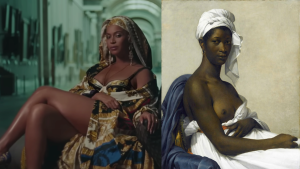Beyoncé: a star who needs no introduction. In a constantly shifting culture, she’s a master of reinvention, shifting genre and aesthetic between album cycles with ease. For art historian Dani Ezor, visiting assistant professor of art history, teaching a course centered on the artist and how her work is racialized in visual culture was a natural fit.
“I've had this course in my mind for many years,” said Ezor. The origin point? “Apeshit,” the 2018 song that Beyoncé and Jay-Z released as a music video, filmed in the Louvre. “I watched that video and was like, okay. Beyoncé just summed up my PhD research in six minutes.” For Ezor, the dynamic and challenging way that the Carters were engaging with art (and renowned art institutions) was an ideal gateway into discussing racialization and reimagining historical works in an academic setting.
In the course, conversations cover both the historical (the focus primarily lies on 15-18th century art) and the contemporary, and how the two convene in dynamic ways. “When Beyoncé takes a picture next to the Mona Lisa, all of a sudden the Mona Lisa has changed,” said Ezor. “It contains new meanings.” Another topic of discussion: Beyoncé’s maternity shoot, a collaboration with photographer Awol Erizku that references both Boticelli’s “Birth of Venus” and the Madonna concept. Held in comparison with “Birth of Oshun,” a 2017 work by Chicago artist Harmonia Rosales that reimagines Botticelli’s Venus as a Nigerian goddess, students are able to confront and interrogate Eurocentric beauty standards in art.
Referencing works of art, both popular and under-seen, is a gesture often seen in Beyoncé’s visual work, from “Lemonade” to “Renaissance.” And she’s not stopping any time soon. In light of her new country album announcement, and Jay-Z's pointed speech at the Grammys that referenced his spouse’s lack of Album of the Year wins, there are many conversations bubbling up regarding the cultural (and racialized) perceptions of her work and how it is embraced.
One artwork blending racial critique into artistry can be found at The Gund: Faith Ringgold’s “Dancing at the Louvre,” a 1991 acrylic piece that incorporates African American quilting techniques and craft with painting and text. “We are so lucky to have it,” said Ezor. “I'm really excited that that will be available for us to dive into, thinking about both women's work, undervalued-ness of craft as art, and continuing to think about that deconstruction of that white western canon.”
Recommended Reading and Viewing
- “Museum in Progress: Decolonizing Museums,” TED Talk by Hannah Mason-Macklin
- “Madame Récamier as Tableau Vivant: Marble and the Classical Ideal in Beyoncé and Jay-Z’s Apesh*t,” by Alicia Caticha, Journal 18 (January 2020).
- “How Skin Color Became a Racial Marker: Art Historical Perspectives on Race,” by Anne Lafont, Eighteenth-Century Studies 51.1 (2017): 89-113.
